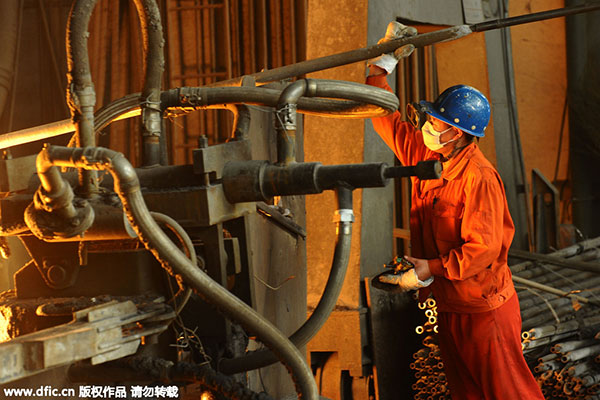 |
|
A woker at a steel mill in Dalian, Northeast China's Liaoning province on Oct 27, 2015. [Photo/IC] |
Several local officials in China's Northeast region sought to explain dramatic economic drops in their areas by admitting they had faked economic data in the past few years to show high growth when the real numbers were much lower, Xinhua News Agency reported on Friday.
"If the past data had not been inflated, the current growth figures would not show such a precipitous fall," one official was quoted as saying.
The report cited several officials in China's Northeast region who acknowledged they had significantly overstated data ranging from fiscal revenue and household income to GDP.
Three years ago Liaoning province's GDP growth was reported at 9.5 percent, but its current figure — over the first three quarters of this year — is just 2.7 percent. Jilin's growth was reported at 12 percent three years ago, but its current rate is 6.3 percent in the same period.
The revelation about the inflated figures came as the GDP growth of the three Northeast provinces ranked the lowest nationwide.
Guan Yingmin, an official in Heilongjiang province, said local investment figures were inflated by at least 20 percent, which translates to nearly 100 billion yuan ($15.7 billion).
Zhao Zhenqi, an official on an economic committee of the Jilin provincial legislature, told Xinhua that combined fixed-asset investment in the province hit 1 trillion yuan. By comparison, total assets of auto manufacturing giant FAW Group, the largest company in the province, was just 240 billion yuan.
If the local financial reports were true, some single counties' GDP would have surpassed Hong Kong. An earlier audit by the National Audit Office found one county in Liaoning that reported annual fiscal revenues 127 percent higher than the actual number.
The report cited numerous examples of entrenched fraud at the local level, saying it was the result of pressure from higher authorities and local officials' desire for promotion.
A staff member in the Jilin provincial finance department, who asked not to be identified, told China Daily that in past years, local officials competed each other to lure external investment projects. They reported the promised investment value, whether it had been achieved or not, as the investment figure.
Beneath the Northeast's malaise, economists said, is the rust belt region's failure over the past decade to shift its growth model away from reliance on heavy industry and outside investment. Unlike other regions, it is mired in a past of command economy that seldom inspires entrepreneurship and outward thinking, said Xu Mengbo, an economics professor at Jilin University.
"It's difficult to get rid of that history and mentality. Even today, corporate managers still wait for the government to tell them what to do when crisis looms," Xu said.
The woes were compounded by officials' inaction, brought on in part by Beijing's anti-corruption campaign, Xu said. Slashing government expenditures weighed on the economy, which is highly dependent on the spending, Xu said.
The Jilin staff member said he had been transferred to Shanghai's fiscal bureaucracy and was impressed by its efficiency, openness and transparency.
"In terms of management ideas, there was at least 10-year gap," he said.
